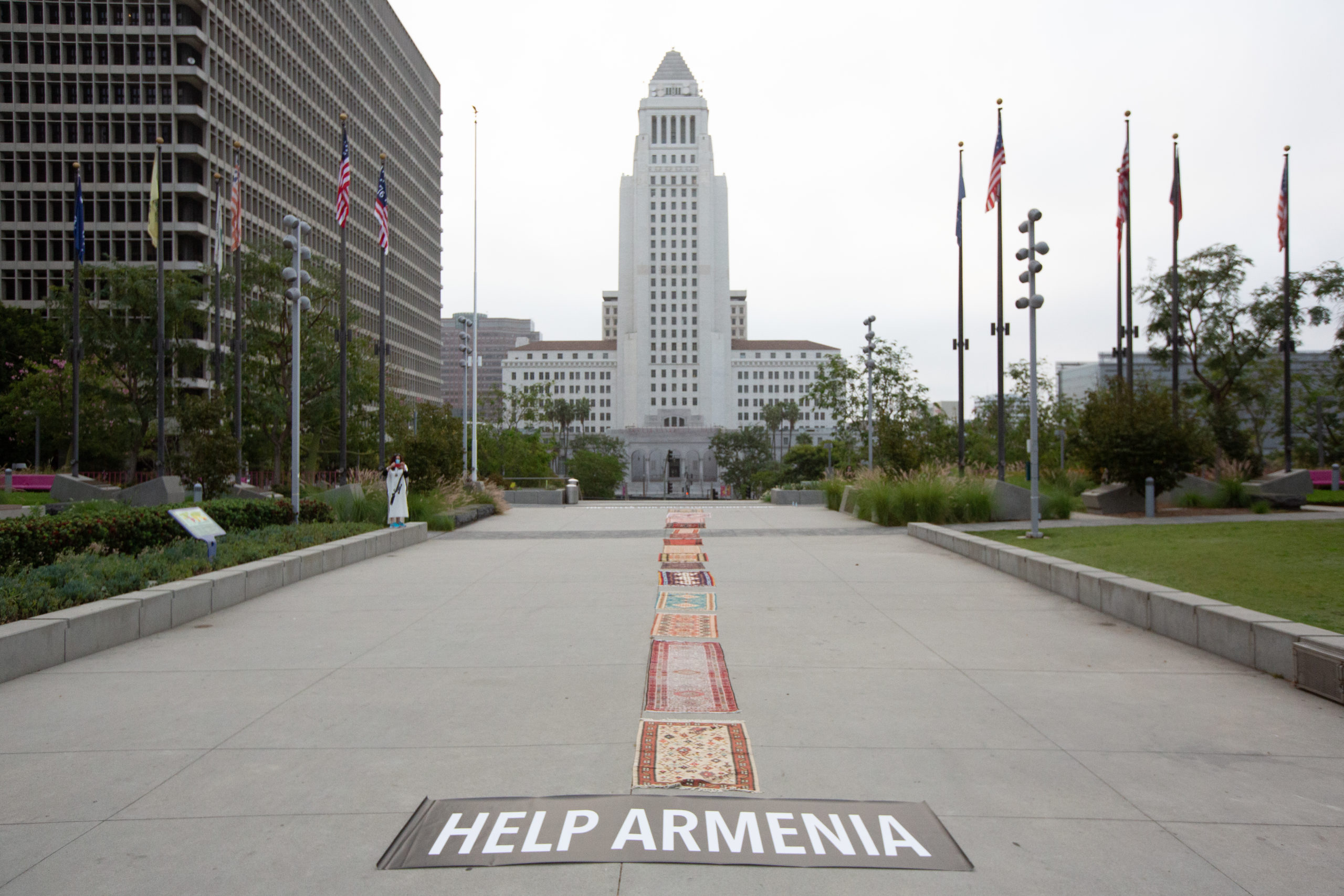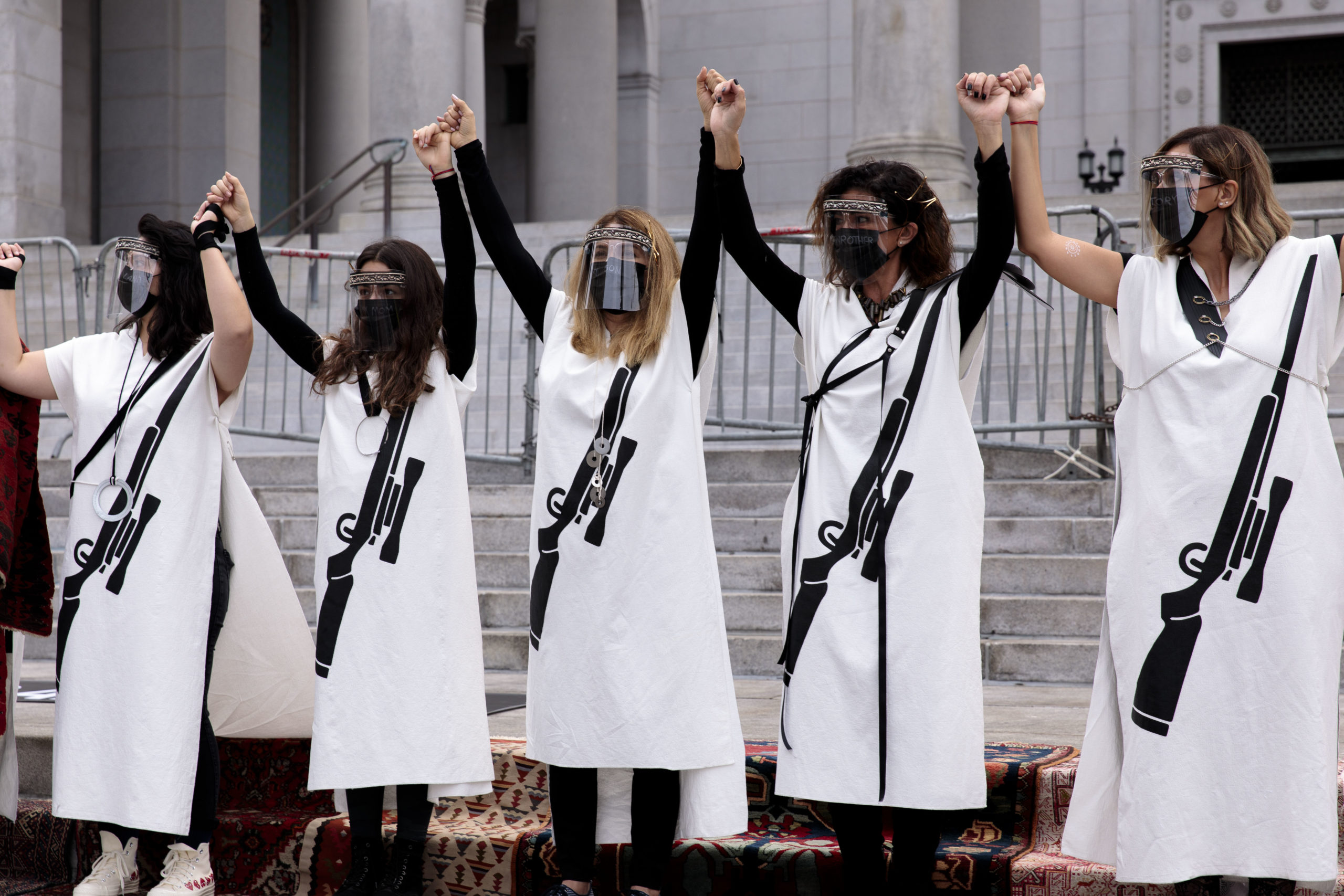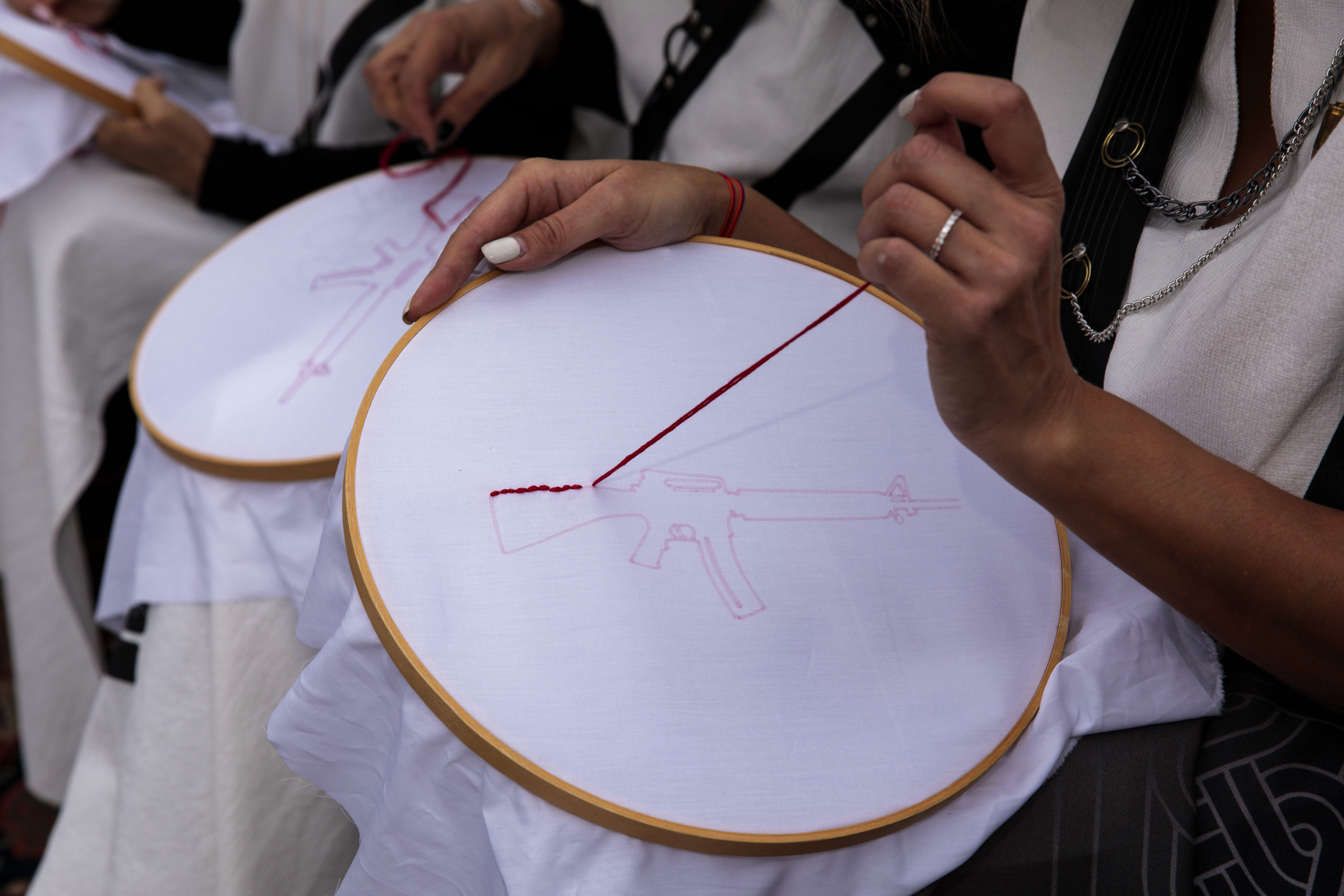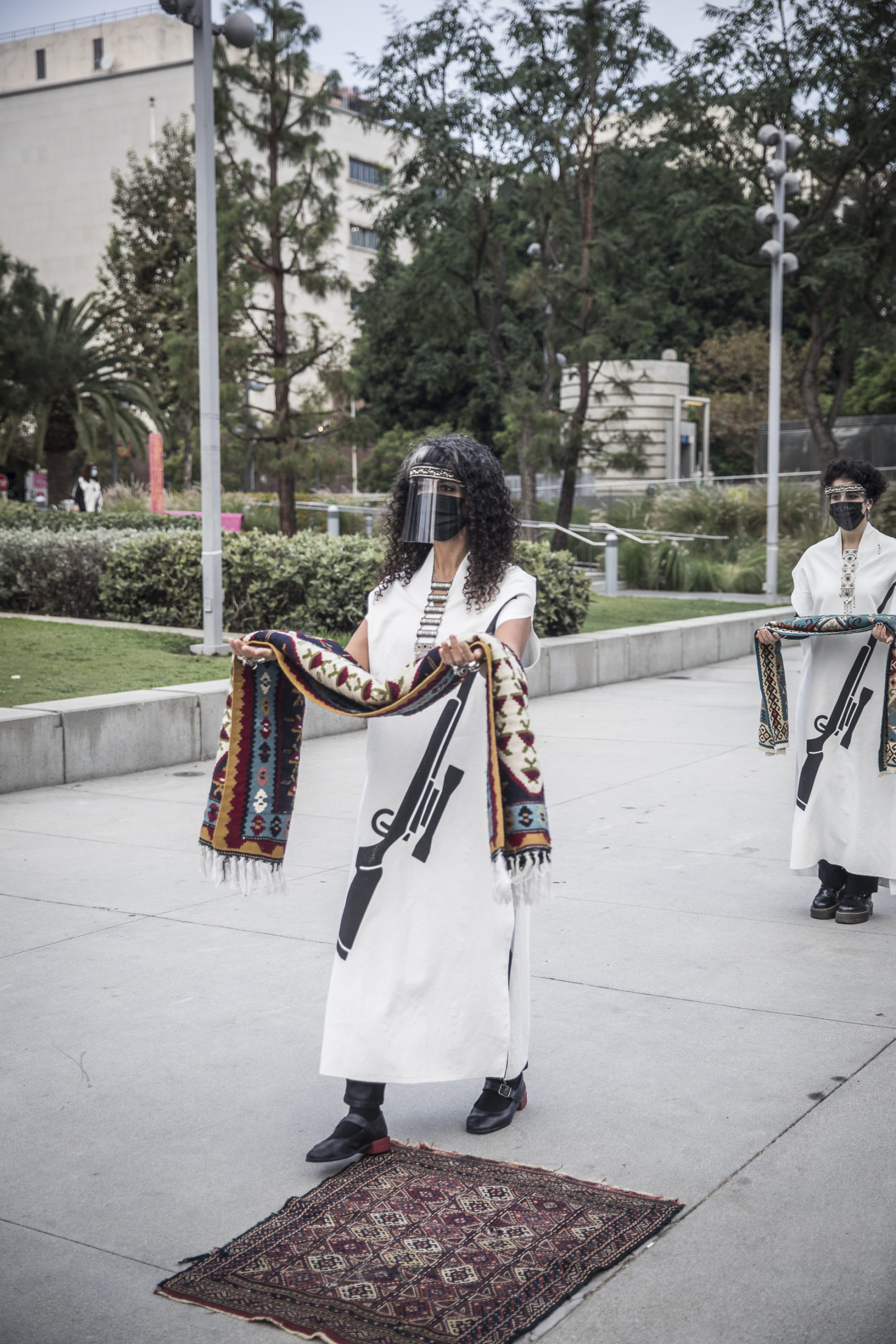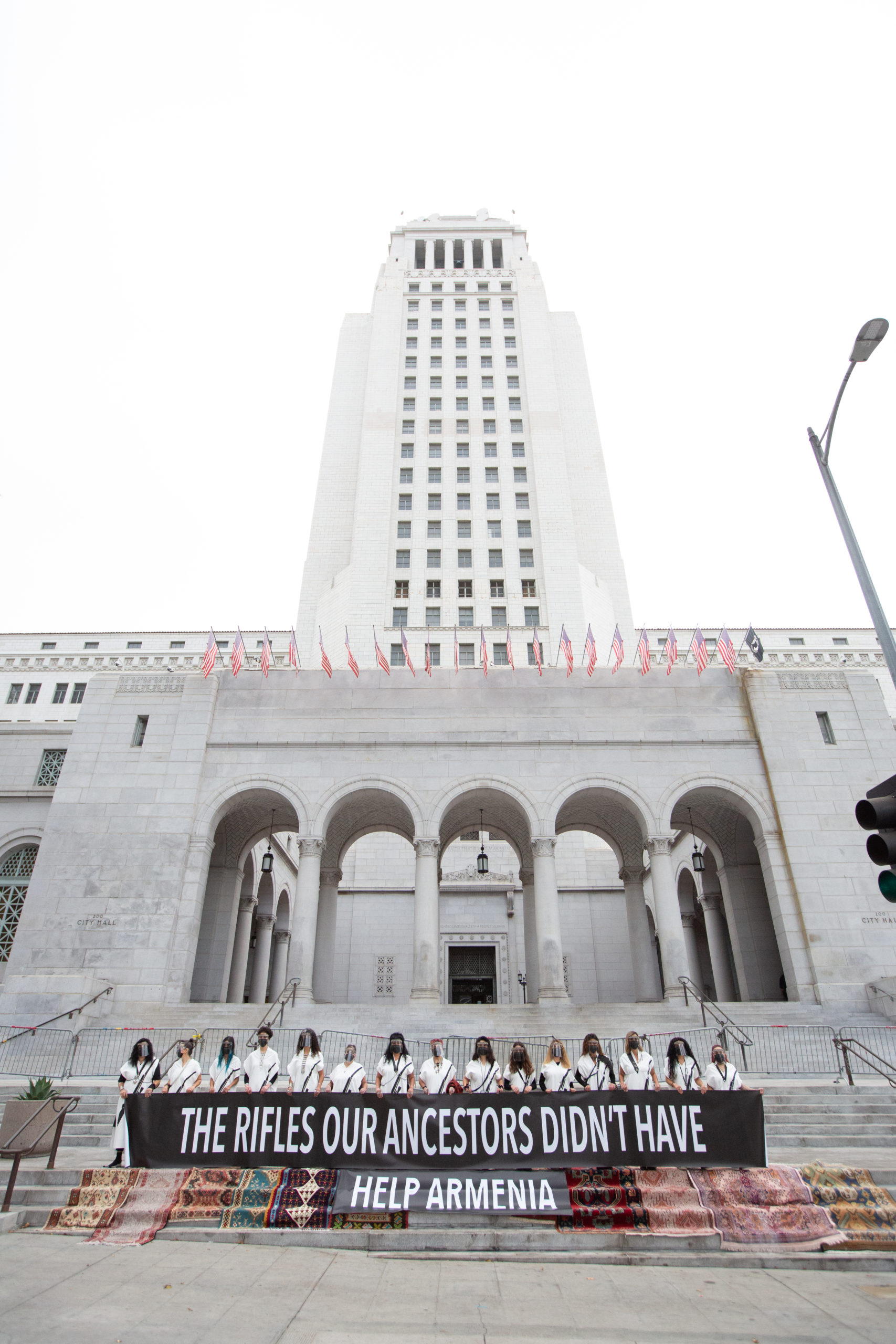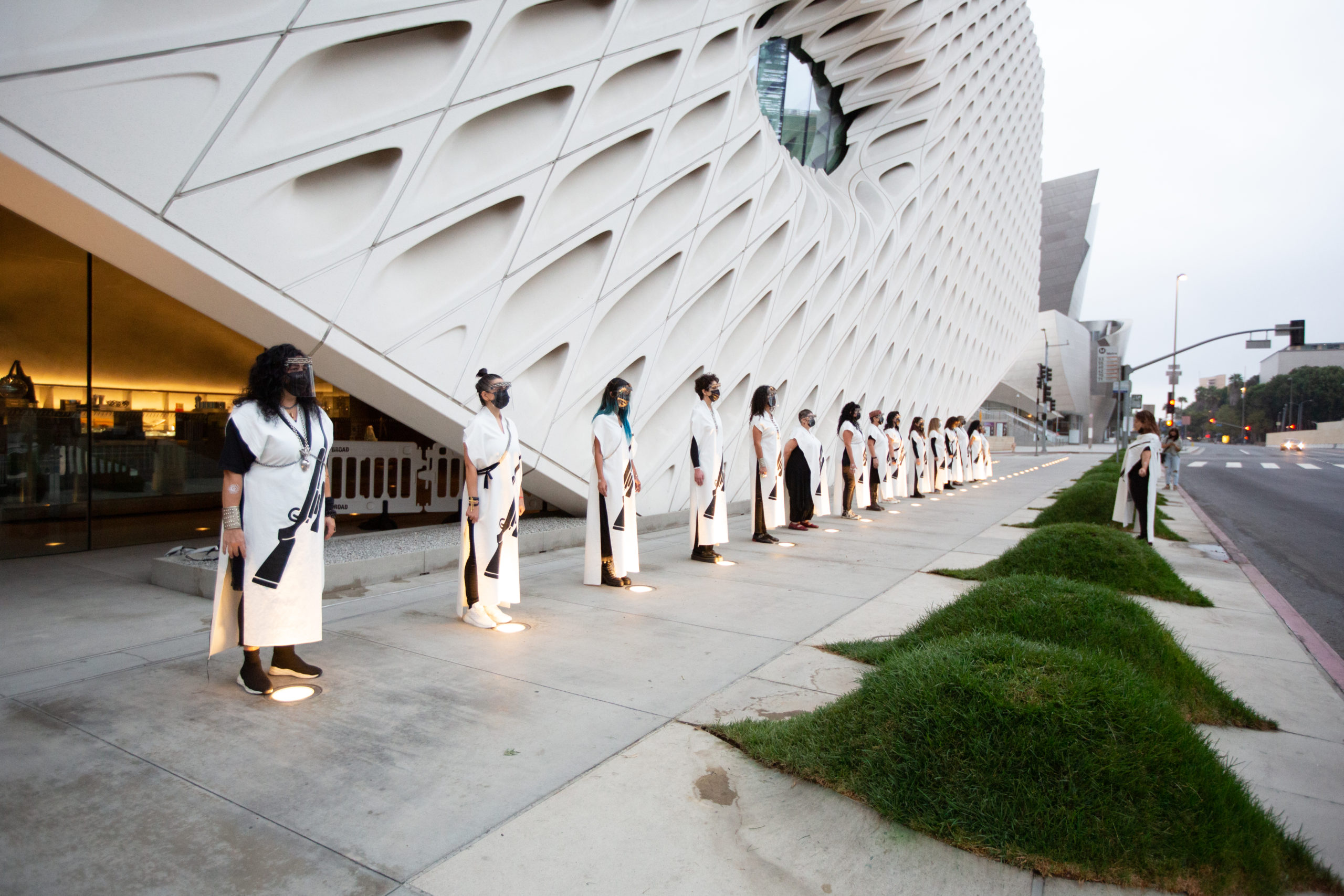Memory Work and Militancy
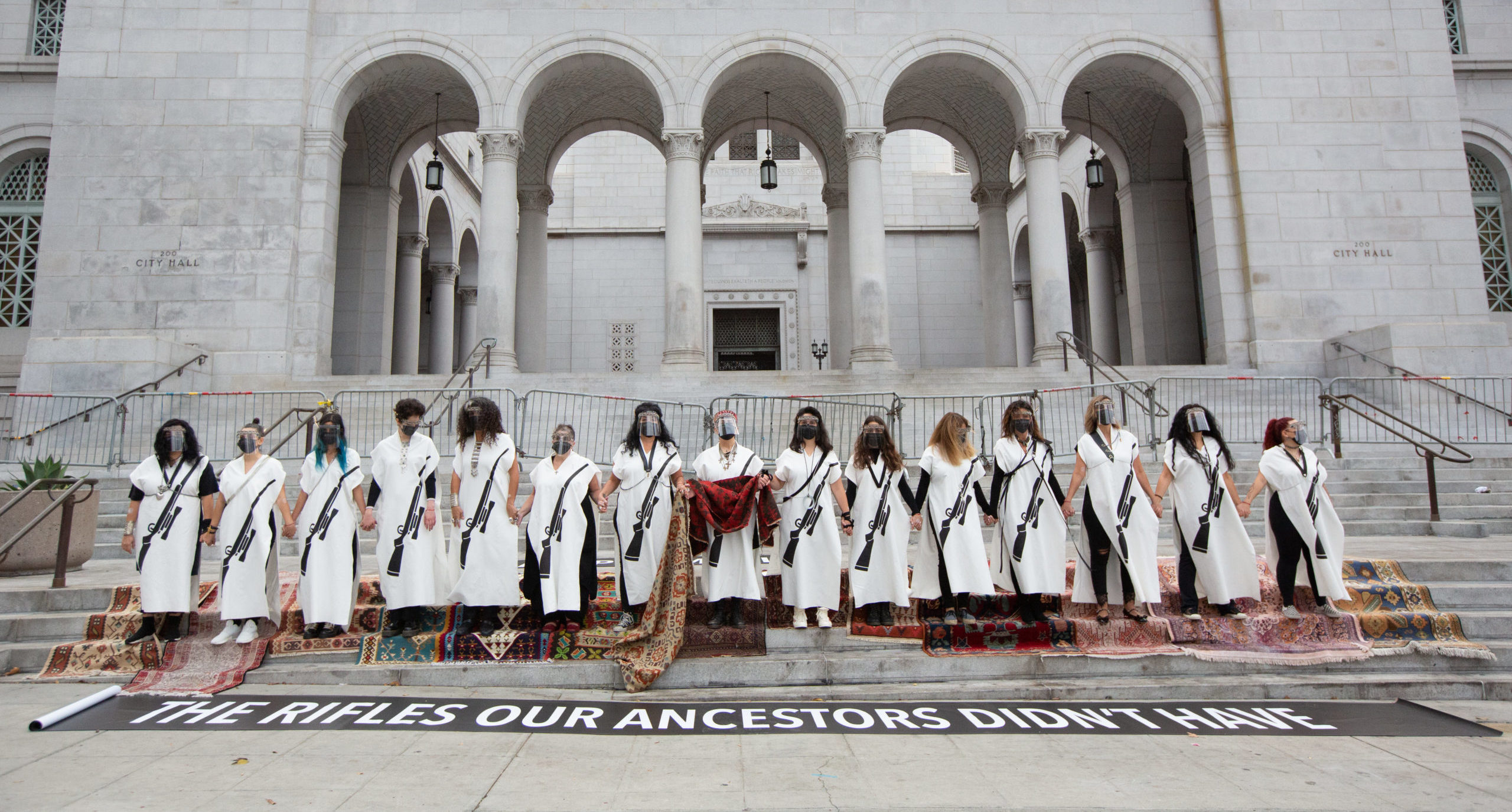
She Loves Collective, The Rifles Our Ancestors Didn’t Have (performance), 2020 [photo: Hilma Photography; courtesy of Mashinka Firunts Hakopian]
Share:
On the morning of October 11, 2020, a hundred thousand Armenian diasporans and their allies in Los Angeles prepared to march for Indigenous self-determination in Artsakh/Nagorno-Karabakh. Seven miles away, a collective of Armenian women artists assembled in solidarity with Artsakh to launch a protest of a different order.
Uniformed in white robes imprinted with rifles, the artists of She Loves Collective ceremonially marched through the streets of downtown LA in an unauthorized performance, chanting its title: “The Rifles Our Ancestors Didn’t Have.” The work’s visual vocabulary drew directly from the gestures and choreographies of nonviolent organizing, and evoked earlier works of feminist protest in public space, such as Adrian Piper’s The Mythic Being and Ema Villanueva’s Pasionaria, walk for dignity. Punctuating the march, participants paused at landmarks including city hall to stage sit-in tableaus, which generated mediagenic imagery designed to circulate widely and amplify the visibility of the crisis.
The performance began in the twilight hours of the morning. After dispersing, artists filed to their cars and joined the tens of thousands who would march to the Turkish consulate and denounce Azerbaijan and Turkey’s neo-Ottoman gambit. The founders of She Loves Collective, Adrineh Baghdassarian and Nelly Achkhen Sarkissian, describe their action as lighting a match in advance of the march: “We ignited that protest that morning.”
In the background of both demonstrations, mediascapes dispensed a continual stream of disinformation about events transpiring in Artsakh. A review of basic facts is necessary, given ongoing contestation around what is unfolding. On September 27, 2020, Azerbaijani forces launched an unprovoked offensive against the Armenian-populated Republic of Artsakh—forcing the out-financed, outgunned, and outnumbered republic into a defensive struggle for self-governance and survival. Over the course of six weeks, constant bombardment and uncounted human rights violations committed by Azerbaijan, with the direct participation of Turkey, claimed more than 2,400 lives and displaced more than 100,000 Artsakhtsis.
She Loves Collective, The Rifles Our Ancestors Didn’t Have (performance), 2020 [photo: Hilma Photography; courtesy of Mashinka Firunts Hakopian]
Azerbaijani cluster munitions and drones supplied by Israel and Turkey assailed civilian sites, including a maternity hospital in Stepanakert and a 19th-century cathedral in Shushi. Breaching international humanitarian law, white phosphorus projectiles set forests ablaze in an act of chemical warfare that environmental agencies condemned as ecocide. With the signing of a November 10 trilateral agreement euphemized as a “peace deal,” Azerbaijani state actors secured the violent seizure of Indigenous lands.
To recount events in Artsakh otherwise requires an act of tactical forgetting. It requires suppressing the histories from which those events emerged: histories that complicate media narratives of timeless territorial disputes in West Asia; histories coded as minor; histories easily forgotten by all but those who still live with their effects in the present.
Training a historical lens on Artsakh means recalling that Armenians have inhabited the region since antiquity. Remember that Azerbaijan’s territorial claim to Artsakh originates in Josef Stalin’s 1921 “gift” of stolen ancestral land to the newly formed Republic of Azerbaijan. Remember that the first time Shushi’s Ghazanchetsots Cathedral was assailed by Azerbaijani military violence happened in 1920, amid the massacre of the city’s Armenian residents. Remember that this episode was not the first (or second) instance of Turkey’s participation in the displacement and dispossession of Indigenous Armenians en masse. In 1915 the Ottoman Empire orchestrated a genocidal campaign of massacres and deportations, resulting in the deaths of 1.5 million Armenians.
These histories surface anew in The Rifles Our Ancestors Didn’t Have. As Hrag Vartanian notes, the visual motif of the armed Armenian woman recalls a widely circulated Ottoman-era photograph of two women Fedayis (freedom fighters). Pictured with their weaponry, they resolutely embody the defiance of early feminist militancy. Baghdassarian and Sarkissian recount that this same photograph “triggered” their performance.
She Loves Collective, The Rifles Our Ancestors Didn’t Have (performance), 2020 [photo: Liana Grigoryan; courtesy of Mashinka Firunts Hakopian]
Official histories of national liberation struggles habitually relegate women to the realm of parenthetical reference. Redressing those omissions, She Loves pointedly centers the crucial labor of women fighters, as well as women cultural producers more broadly.
“Every time I Google ‘Armenian women artists,’” Sarkissian observes, “I get photos of men …. They’re all the same men, dressed in the same clothes, in front of those Armenian primary color paintings.” To correct the under-representation of Armenian women artists in digital space, She Loves has convened “activations,” akin to the Art+Feminism Wikipedia Editathon, focused on proliferating digital content related to contemporary Armenian women artists.
In a similar vein, Rifles attends to the undervalued and undercompensated feminized labor of Armenian craft work. Outside LA City Hall, the artists assembled on top of woven Armenian carpets and began collectively stitching images of rifles onto individual sewing hoops. They reproduced diasporic memory through an act of weaving what Anne-Marie Fortier has called a “thread of continuity.”1 For Baghdassarian and Sarkissian, the act was linked not only to the struggle in Artsakh but to “the fight to prove that there is something valuable in [our] work.” The highly choreographed, synchronized nature of their activity demonstrated what can be done when the dispossessed organize.
She Loves Collective, The Rifles Our Ancestors Didn’t Have (performance), 2020 [photo: Liana Grigoryan; courtesy of Mashinka Firunts Hakopian]
What the performance ultimately calls for is not militarization but self-determination. Its titular rifles don’t extol the weapons of military violence. Rather, they make a claim for how the continued existence of people targeted for annihilation constitutes a kind of victory. The artists argue for the diasporic body that performs cultural memory as a weapon against the forces of historical erasure. To put a fine point on their argument, the size of the rifles silkscreened on the artists’ robes was carefully calibrated during the design process. The rifles had to be “fifty-two inches and not an inch shorter,” to cover the performer’s entire body and code that body as a weapon.
She Loves Collective, The Rifles Our Ancestors Didn’t Have (performance), 2020 [photo: Jake Hagopian; courtesy of Mashinka Firunts Hakopian]
She Loves Collective, The Rifles Our Ancestors Didn’t Have (performance), 2020 [photo: Hilma Photography; courtesy of Mashinka Firunts Hakopian]
Notably, what scholars term the “responsibility to recall” in diasporic communities is often coded as a feminized practice.2 The preservation of cultural memory is cast as invisible and gendered labor, as is the unwaged reproduction of communal social life. Rifles turns these formulations on their head, recasting the labor of recollection as an active force of political transformation. In this way, the performance weaponizes feminist memory work as organized resistance.
She Loves Collective, The Rifles Our Ancestors Didn’t Have (performance), 2020 [photo: Hilma Photography; courtesy of Mashinka Firunts Hakopian]
Today Armenian monuments and artifacts dating back centuries face the imminent threat of destruction in occupied Artsakh. These objects attest to the histories of Indigenous Armenians, who have inhabited the region since the second century BCE. They are situated in territories now controlled by Azerbaijani state actors, whose program of ethnic cleansing has long been accompanied by a policy of cultural genocide. By serving as an aid to memory, these artifacts undermine the territorial claims of a neocolonial regime that relies on historical erasure to shore up its legitimacy. Under these conditions, to perform memory work is to arm oneself in the ongoing struggle for self-determination.
The author of this review is donating the writer’s fee to Kooyrigs, an organization that provides urgent, transparent, on-the-ground aid to persons displaced by the crisis in Artsakh. To donate to Kooyrigs, please click here.
References
| ↑1 | Anne-Marie Fortier, “Diaspora,” in Cultural Geography: A Critical Dictionary of Key Concepts, eds. David Sibley, Peter Jackson, David Atkinson, and Neil Washbourne (London: I.B. Tauris, 2005), 184. |
|---|---|
| ↑2 | The “responsibility to recall” is discussed in the introduction to Diaspora and Memory: Figures of Displacement in Contemporary Literature, Arts and Politics, eds. Marie-Aude Baronian, Stephan Besser, and Yolande Jansen (Amsterdam: Rodopi, 2007), 12 |
